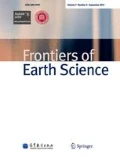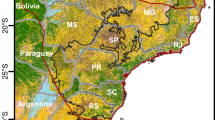Abstract
Understanding patch variability is crucial in understanding the spatial population structure of wildlife species, especially for rare or threatened species. We used a well-tested maximum entropy species distribution model (Maxent) to map the Yosemite toad (Anaxyrus (= Bufo) canorus) in the Sierra Nevada mountains of California. Twenty-six environmental variables were included in the model representing climate, topography, land cover type, and disturbance factors (e.g., distances to agricultural lands, fire perimeters, and timber harvest areas) throughout the historic range of the toad. We then took a novel approach to the study of spatially structured populations by applying the species-environmental matching model separately for 49 consistently occupied sites of the Yosemite toad compared to 27 intermittently occupied sites. We found that the distribution of the entire population was highly predictable (AUC = 0.95±0.03 SD), and associated with low slopes, specific vegetation types (wet meadow, alpine-dwarf shrub, montane chaparral, red fir, and subalpine conifer), and warm temperatures. The consistently occupied sites were also associated with these same factors, and they were also highly predictable (AUC = 0.95±0.05 SD). However, the intermittently occupied sites were associated with distance to fire perimeter, a slightly different response to vegetation types, distance to timber harvests, and a much broader set of aspect classes (AUC = 0.90±0.11 SD). We conclude that many studies of species distributions may benefit by modeling spatially structured populations separately. Modeling and monitoring consistently-occupied sites may provide a realistic snapshot of current species-environment relationships, important climatic and topographic patterns associated with species persistence patterns, and an understanding of the plasticity of the species to respond to varying climate regimes across its range. Meanwhile, modeling and monitoring of widely dispersing individuals and intermittently occupied sites may uncover environmental thresholds and human-related threats to population persistence.
Similar content being viewed by others
References
Alford R A, Richards S J (1999). Global amphibian declines: a problem in applied ecology. Annu Rev Ecol Syst, 30(1): 133–165
Bradford D F, Neale A C, Nash M S, Sada D W, Jaeger J R (2003). Habitat patch occupancy by toads (Bufo punctatus) in a naturally fragmented desert landscape. Ecology, 84(4): 1012–1023
Davidson C, Shaffer H B, Jennings M R (2002). Spatial tests of the pesticide drift, habitat destruction, UV-B, and climate-change hypotheses for California amphibian declines. Conserv Biol, 16(6): 1588–1601
Drost C A, Fellers G M (1996). Collapse of a regional frog fauna in the Yosemite area of the California Sierra Nevada, USA. Conserv Biol, 10(2): 414–425
Elith J, Graham C H, Anderson R P, Dudik M, Ferrier S, Guisan A, Hijmans R J, Huettmann F, Leathwick J R, Lehmann A, Li J, Lohmann L G, Loiselle B A, Lohmann G, Manion G, Moritz C, Overton J M, Peterson A T, Phillips S J, Nakamura M, Nakazawa Y, Schapire R E, Wisz M S, Zimmermann N E (2006). Novel methods improve prediction of species’ distributions from occurrence data. Ecography, 29: 129–151
Evangelista P H, Kumar S, Stohlgren T J, Jarnevich C S, Crall A W, Norman J B III, Barnett D T (2008). Modelling invasion for a habitat generalist and a specialist plant species. Divers Distrib, 14(5): 808–817
Ficetola G F, Thuiller W, Miaud C (2007). Prediction and validation of the potential global distribution of a problematic alien invasive species—the American bullfrog. Divers Distrib, 13(4): 476–485
Frankham R, Ballou J D, Briscoe D A (2002). Introduction to conservation genetics. Cambridge University Press, Cambridge
Fuller T, Morton D P, Sarkar S (2008). Incorporating uncertainty about species’ potential distributions under climate change into the selection of conservation areas with a case study from the Arctic Coastal Plain of Alaska. Biol Conserv, 141(6): 1547–1559
Funk WC, Greene A E, Corn P S, Allendorf FW (2005). High dispersal in a frog species suggests that it is vulnerable to habitat fragmentation. Biol Lett, 1(1): 13–16
Giovanelli J G R, Haddad C F B, Alexandrino J (2008). Predicting the potential distribution of the alien invasive American bullfrog (Lithobates catesbeianus) in Brazil. Biol Invasions, 10(5): 585–590
Hanski I (1999). Metapopulation Ecology. New York: Oxford University Press
Harrison S, Taylor A D (1997). Empirical evidence for metapopulation dynamics. In: Hanski I, Gilpin M E, eds. Metapopulation Dynamics: Ecology, Genetics and Evolution. New York: Academic Press, 27–42
Heisswolf A, Reichmann S, Poethke H J, Schrader B, Obermaier E (2009). Habitat quality matters for the distribution of an endangered leaf beetle and its egg parasitoid in a fragmented landscape. J Insect Conserv, 13(2): 165–175
Jarnevich C S, Stohlgren T J (2009). Near term climate projections for invasive species distributions. Biol Invasions, 11(6): 1373–1379
Karlstrom E L (1962). The toad genus Bufo in the Sierra Nevada of California. Univ Calif Publ Zool, 62: 1–104
Kokko H, López-Sepulcre A (2006). From individual dispersal to species ranges: perspectives for a changing world. Science, 313(5788): 789–791
Kumar S, Spaulding S A, Stohlgren T J, Hermann K A, Schmidt T S, Bahls L L (2009). Predicting habitat distribution for freshwater diatom Didymosphenia geminata in the continental United States. Front Ecol Environ, 7: 415–420
Levins R A (1969). Some demographic and evolutionary consequences of environmental heterogeneity for biological control. Bull Entomol Soc Am, 15: 237–240
Li M Y, Ju Y W, Kumar S, Stohlgren T J (2008). Modeling potential habitats for alien species Dreissena polymorpha (Zebra mussel) in the Continental USA. Acta Ecol Sin, 28(9): 4253–4258
Lloyd H (2008). Influence of within-patch habitat quality on high-Andean Polylepis bird abundance. Ibis, 150(4): 735–745
Marsh D M, Trenham P C (2001). Metapopulation dynamics and amphibian conservation. Conserv Biol, 15: 40–49
Mortelliti A, Amori G, Boitani L (2010). The role of habitat quality in fragmented landscapes: a conceptual overview and prospectus for future research. Oecologia, 163(2): 535–547
Pawar S, Koo M S, Kelley C, Ahmed M F, Chaudhuri S, Sarkar S (2007). Conservation assessment and prioritization of areas in Northeast India: Priorities for amphibians and reptiles. Biol Conserv, 136(3): 346–361
Pearson R G, Raxworthy C J, Nakamura M, Peterson A T (2007). Predicting species distributions from small numbers of occurrence records: A test case using cryptic geckos in Madagascar. J Biogeogr, 34(1): 102–117
Petranka JW, Holbrook C T (2006).Wetland restoration for amphibians: should local sites be designed to support metapopulations or patchy populations? Restor Ecol, 14(3): 404–411
Phillips B L, Brown G P, Webb J K, Shine R (2006a). Invasion and the evolution of speed in toads. Nature, 439(7078): 803
Phillips S J, Dudik M, Schapire R E (2004). A maximum entropy approach to species distribution modeling. Brodley C E, ed. In: Proceedings of the 21st International Conference on Machine Learning. New York: ACM Press, 655–662
Phillips S J, Anderson R P, Schapire R E (2006b). Maximum entropy modeling of species geographic distributions. Ecol Modell, 190(3–4): 231–259
Pilliod D S, Bury R B, Hyde E J, Pearl C A, Corn P S (2003). Fire and amphibians in North America. For Ecol Manage, 178(1–2): 163–181
Pulliam H R (1988). Sources, sinks, and population regulation. Am Nat, 132(5): 652–661
Riley S P D, Busteed G T, Kats L B, Vandergon T L, Lee L F S, Dagit R G, Kerby J L, Fisher R N, Sauvajot R M (2005). Effects of urbanization on the distribution and abundance of amphibians and invasive species in Southern California streams. Conserv Biol, 19(6): 1894–1907
Schooley R L, Branch L C (2009). Enhancing the area-isolation paradigm: habitat heterogeneity and metapopulation dynamics of a rare wetland mammal. Ecol Appl, 19(7): 1708–1722
Semlitsch R D, Todd B D, Blomquist SM, Calhoun A J K, Gibbons JW, Gibbs J P, Graeter G J, Harper E B, Hocking D J, Hunter M L Jr, Patrick D A, Rittenhouse T A G, Rothermel B B (2009). Effects of timber harvest on amphibian population: Understanding mechanisms from forest experiments. Bioscience, 59(10): 853–862
Sherman C K, Morton M L (1993). Population declines of Yosemite toads in the eastern Sierra Nevada of California. J Herpetol, 27(2): 186–198
Smith M A, Green D M (2005). Dispersal and the metapopulation paradigm in amphibian ecology and conservation: Are all amphibian populations metapopulations? Ecography, 28: 110–128
Svenning J C, Normand S, Kageyama M (2008). Glacial refugia of temperate trees in Europe: Insights from species distribution modelling. J Ecol, 96(6): 1117–1127
U.S. Fish and Wildlife Service (USFWS) (2002). 12-month finding for a petition to list the Yosemite toad. Federal Register, 67: 75834–75843
Waltari E, Guralnick R P (2009). Ecological niche modelling of montane mammals in the Great Basin, North America: examining past and present connectivity of species across basins and ranges. J Biogeogr, 36(1): 148–161
Author information
Authors and Affiliations
Corresponding author
Rights and permissions
About this article
Cite this article
Liang, C.T., Stohlgren, T.J. Habitat suitability of patch types: A case study of the Yosemite toad. Front. Earth Sci. 5, 217–228 (2011). https://doi.org/10.1007/s11707-011-0157-2
Received:
Accepted:
Published:
Issue Date:
DOI: https://doi.org/10.1007/s11707-011-0157-2




